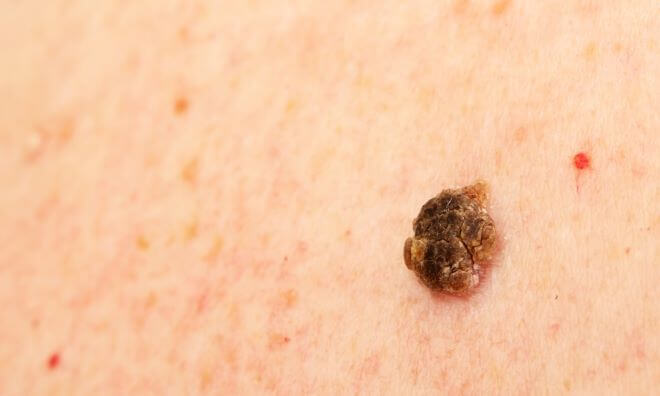If you’ve been diagnosed with seborrheic keratoses or suspect a new skin growth may be early-stage seborrheic keratosis, you may be wondering what exactly this skin condition is and what you should do about it. In this blog, Dr. Aaron Fong of U. S. Dermatology Partners in Sterling, Virginia, is going to review the top five things you should know about early-stage seborrheic keratoses. According to Dr. Fong, “Seborrheic keratoses can look a little alarming, but they’re actually a common type of skin growth that is not dangerous, cancerous, or contagious. By learning more about seborrheic keratosis, you can avoid unnecessary worrying when these growths appear since they’re perfectly safe.”
1 – Seborrheic Keratosis Is Noncancerous
It’s important to start any discussion on seborrheic keratoses with the fact that these common skin growths are not cancerous, they don’t typically spread, they’re not contagious, they don’t pose a risk to skin or whole-body health, and typically, they don’t require treatment. The seborrheic keratoses growths themselves are noncancerous, and unlike moles, they do not develop into melanoma.
According to Dr. Fong, “While seborrheic keratoses are noncancerous, they can often look like cancerous growths. For this reason, your dermatologist may recommend removal. This allows the dermatologist to perform a biopsy and test the growth to ensure there is no cancer present. As long as it’s clear that seborrheic keratoses are noncancerous, your dermatologist will not likely recommend removal or other treatments unless the location of the growth is uncomfortable, unsightly, easily irritated, or gets caught on clothing or jewelry.”
2 – Seborrheic Keratoses Grow Slowly
Seborrheic keratoses grow very slowly. In most cases, the growths will not spread very far or grow too extensively. However, some people do see a greater number of growths that spread further than others. Everyone is different, so if your seborrheic keratoses are growing rapidly, that doesn’t necessarily mean it’s another condition. However, it’s always best to have any new skin growth examined by a dermatologist. While seborrheic keratoses don’t often grow or spread extensively, they also don’t go away on their own. Once a growth appears, you’ll likely have it forever.
3 – The Appearance of Seborrheic Keratosis Can Vary Widely
According to Dr. Fong, “Because the appearance of seborrheic keratoses can vary so widely, it can be difficult for individuals to make an accurate self-diagnosis. It’s important to schedule a consultation and exam with a skilled dermatologist who can accurately diagnose seborrheic keratosis and ensure your skin growth isn’t a more serious condition.”
While the appearance of seborrheic keratoses does vary, there are some common characteristics you can look for, including:
- Often develop as multiple lesions
- Some growths have a rough, wart-like texture and appearance
- Some growths have a smooth, waxy texture and appearance
- Color will vary from tan to dark brown or black
- Growths are usually round or ovular
- They are often slightly raised from the skin and look stuck on to the skin’s surface
- Growths may be very small or grow up to an inch in diameter
You should visit a dermatologist for seborrheic keratosis if:
- You have numerous, fast-growing seborrheic keratoses
- Skin growths bleed or are easily irritated
- Seborrheic keratoses are itching or painful
- You notice growths that are growing rapidly, bleeding, turning black, or that don’t look like other seborrheic keratosis spots on your body, which may be a sign of skin cancer
- The skin growth looks flat, dry, or scaly, which may indicate that it’s a precancerous growth called an actinic keratosis that can develop into skin cancer
- You suddenly notice numerous seborrheic keratosis growths as well as other new skin growths, which can be a warning sign of cancer in other parts of the body
4 – Seborrheic Keratosis Can Appear Almost Anywhere on Your Skin
About the location of seborrheic keratoses growths, Dr. Fong says, “These skin growths may develop on any part of the body, but they are most common on the face, head, neck, chest, shoulders, and back. Darker-skinned people are less likely to develop seborrheic keratosis growths, but they may see some small skin growths that usually develop around the eyes. The only place seborrheic keratoses won’t develop is on the palms of hands and soles of feet.”
5 – Seborrheic Keratosis Typically Show Up Around Middle Age
Seborrheic keratosis can develop at any time on any person. However, they are much more likely to develop in adults over the age of 50, and the risk of developing seborrheic keratoses increases with age. According to Dr. Fong, “Seborrheic keratoses are so common for patients over the age of 50 and the appearance is so similar to warts that they have earned the unfortunate nickname ‘barnacles of aging.’ Children and younger adults may also have seborrheic keratoses growths, but this is rare.”
There is no one specific cause for seborrheic keratosis, but there is an increased risk for these skin growths for patients who meet any of the following characteristics:
- Over the age of 50
- Experiencing hormonal fluctuation (hormone replacement, pregnancy, etc.)
- Have one or more family members who have seborrheic keratoses
- Have light skin
Concerned About Seborrheic Keratosis? Reach Out to U.S. Dermatology Partners Today!
According to Dr. Fong, “In most cases, you won’t need any treatment for seborrheic keratosis, but if you’re concerned or want to verify your self-diagnosis, don’t hesitate to reach out to schedule a consultation. Your dermatologist can confirm that the growth is seborrheic keratosis, answer any questions you have, and provide treatment if it’s necessary. It’s always better to have a professional diagnose any new growth to ensure you don’t accidentally miss a potentially dangerous skin condition.”
If you’re ready to get started working with a dermatologist, simply complete our online schedule request form at any time. Once a local U.S. Dermatology Partners practice receives your request, they’ll be in touch to finalize the details of your visit. They can also answer any questions you have.
Find a location near me
or


